Fritillary flowers are perennial bulbous plants that are widespread in the gardens of the middle lane. A huge number of species and varieties of hazel grouse makes it possible to choose exactly those flowers that will fit perfectly into the composition of your flower bed. In addition, when growing hazel grouse, it is recommended to transplant plants to a new place quite often, which means that every year you can admire these flowers in different parts of your garden.
Types and varieties of grouse flowers with a photo
One of the most beloved spring primroses by gardeners is fritillaria (Fritillaria) , or hazel grouse, from the lily family. This flower was called hazel grouse for its variegated color:
monochromatic, “boring” specimens are rare. There are about 150 species of hazel grouse, there are fewer cultivated varieties of hazel grouse, but they are all charming in their own way.
Fritillaries are bulbous perennials , some varieties bloom among the first – in mid-April. The flowering period is usually about 2 weeks.
If planted on a plot of a variety with a different beginning of the budding period, these flowers will delight the eye until June. The sprouts of all types of grouse flowers appear from under the snow long before flowering, and already at the end of March, the garden is decorated with green shoots – harbingers of the awakening of nature.
Fritillaries, like most spring-flowering bulbs, die off in the summer, the bulb hibernates in the soil, and then sprouts reappear. Grouse should be transplanted to a new place quite often – once every 2-4 years.
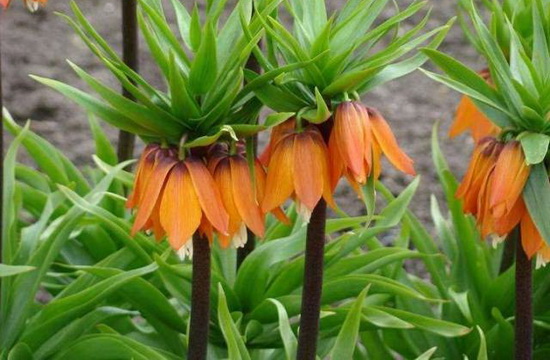
Look at the photo: all types of hazel grouse are bells lowered down, the color can be different – from snow-white to bright orange and purple.
The stem is quite tall, fleshy. Leaves are long, narrow, lanceolate. The hazel grouse is respectfully called the “royal crown” for the similarity of its colors with the royal headdress.
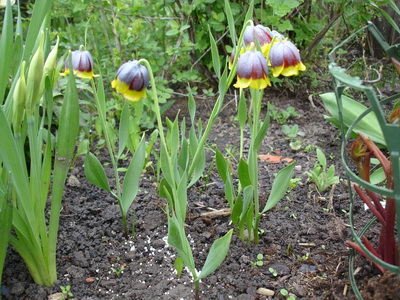
The most popular type of hazel grouse is imperial hazel grouse . This amazing flower is also called the “tree of paradise”. The height of the bush reaches up to 1m.

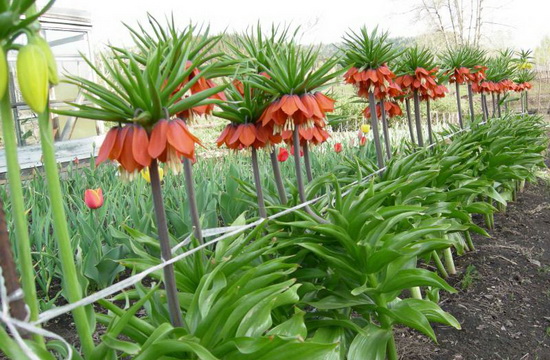
As you can see in the photo of the hazel grouse, the flowers of this variety look like a small palm tree.
Leaves grow on a bare stem near the ground, and the foliage also forms a kind of crown at the top, under which drooping bells of bright flowers are “attached”. Their color can be in yellow, red or orange, other shades are not found. Usually the petals are covered with veins of a more saturated color, the anthers are white, longer than the petals. Flowering in imperial hazel grouse begins earlier than in many primroses.
Imperial hazel grouse prefers partial shade, warmth and lack of drafts. These flowers tolerate spring frosts well. At the time of lowering the temperature (down to -6 ° C), the stems freeze slightly, and during the thaw they come to life again. Imperial hazel grouse requires a transplant every 2-3 years.
Most often in the gardens you can find the Sulferino variety, it is unpretentious and very decorative.
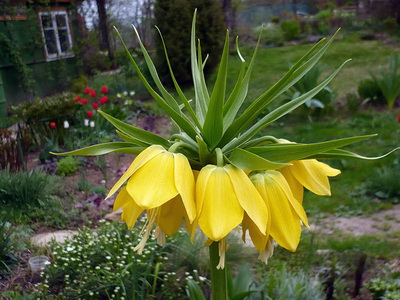
Low bushes in the variety Aurora , taller varieties “Luteya” and “Luteya Maxima”.
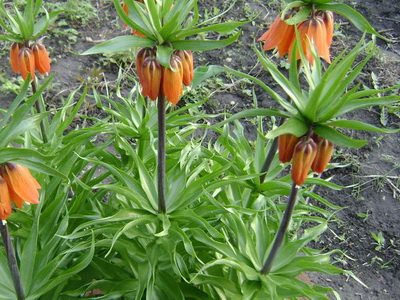
At Lyutei maxima , the stems reach 1.2 m in height.
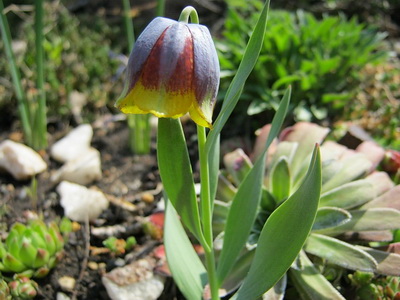
The hazel grouse of the “Chess” variety reaches a height of 40 cm, single flowers are each located on a separate drooping stem. Less common are varieties in which two drooping flowers are attached to one stem. The color of the petals is interesting – small alternating spots of purple and white shades resemble a chessboard.

The most unpretentious varieties of chess hazel grouse:
“Alba”

“Aphrodite”

“Artemis”
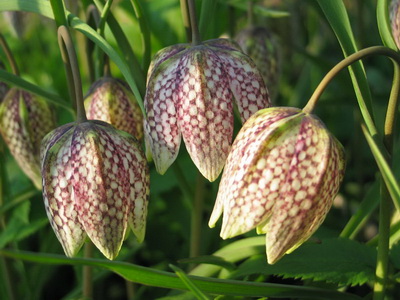
“Jupiter” .

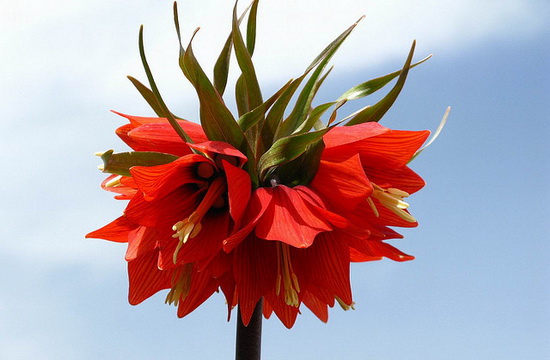
Pay special attention to the photo of the hazel grouse variety “Jupiter”: these flowers stand out with rich red flowers of large size.
The Russian hazel grouse is distinguished by a rich burgundy color of flowers. Flowers on the stem are arranged in a brush of 2-5 pieces. This flower is often found in city flower beds and parks.
Planting and feeding hazel grouse in spring
For successful care and reproduction of hazel grouse, open sunny areas are chosen, but it is possible to grow flowers in partial shade. Therefore, they are suitable for planting under deciduous shrubs and trees, near a country house, terrace and gazebo, as well as on the western and southwestern slopes.
The soil for these plants requires fertile, well-drained soil. If you use humus for drainage, then fertilizers can be applied in smaller quantities, since the rotted manure mass itself is an excellent top dressing.
Fertilizing hazel grouse in the spring is done with a mixture of humus and peat in a ratio of 1: 3, as well as mineral fertilizers such as superphosphate and urea. When caring for and growing hazel grouses, the first feeding is done at the end of April, during the formation of buds. The next time the plants are fertilized after flowering with a solution of superphosphate and potassium sulfate.
Grouse care and flower propagation
Grouse are propagated most often by dividing the bulbs. Bulbs for babies should be dug in late June – early July, until the foliage is completely dry. As a rule, one or two daughter bulbs are formed on the mother bulb. The dug out bulbs are divided into children and disinfected with a weak solution of potassium permanganate. Bulbs can be stored for a short time – within 2-3 weeks in a dry, ventilated room at an air temperature of no higher than 30 C. During storage, roots and sprouts begin to grow in the bulbs. Bulbs should be handled with extreme care as they do not have protective scales. For the same reason, bulbs should be planted immediately after purchase in a store or market. Make sure that the bulbs are not overdried, such specimens are unlikely to germinate.
In the spring, hazel grouse does not require abundant watering. Watering plants is necessary only in case of dry weather. Fritillaries can die due to regular waterlogging. Flowers must be cleaned of weeds and loosen the soil.
When planting and caring for hazel grouse in the open field, loosen carefully, because the roots of the plant may be at the very surface. Growing grouse flowers in a dry summer involves frequent watering even after the aerial part dies off, so that the bulbs in the ground do not dry out. Watering is sufficient to produce 1-2 times a month.
For the winter, planting hazel grouse is recommended to cover. In early spring, when the ground thaws, the shelter must be removed so that the seedlings germinate without interference.
Growing and caring for hazel grouse in the open field
Grouse bulbs are planted and transplanted into open ground in late August – September. Planting depth – from 6 to 20 cm, depending on their size. The largest bulbs of hazel grouse are sometimes deepened by 30 cm, while the plants develop better. A distance of 20-30 cm is left between the holes, since the grouse bushes are quite large. Humus is poured at the bottom of the hole, and if the soil is heavy, coarse-grained sand or wet peat is added. Since hazel grouses prefer neutral soil, liming or adding wood ash can be done before planting.
Grouse should not be planted in cool, rainy weather. The soil during planting should not be cold and wet, otherwise the bulbs and roots will quickly begin to rot.
Grouse bulbs have an unusual feature – they repel moles and rodents. For this reason, these flowers are often planted for protective purposes around flower beds and fruit trees. The ideal option is to distribute groups of hazel grouse throughout the garden.
If you choose varieties of different shades and shapes for such plantings, the garden in spring will always have an elegant look and at the same time have additional protection from pests.







